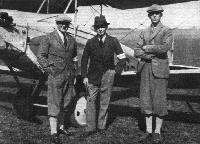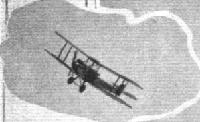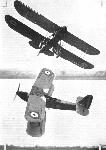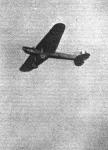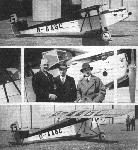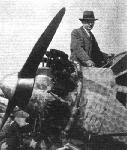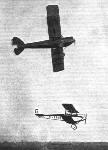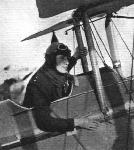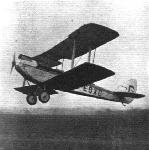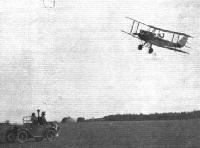Фотографии
-
Регистрационный номер: G-EBLF [3] THE AIR ROUTE TO INDIA: The Armstrong-Whitworth "Argosy" (three Armstrong-Siddeley "Jaguars") "City of Glasgow," which opened the service on March 30.
Самолёты на фотографии: Armstrong Whitworth Argosy - Великобритания - 1926
-
Регистрационный номер: G-EBLF [3] THE FIRST AIR MAILS FROM INDIA: The Armstrong-Whitworth "Argosy" airliner, "City of Glasgow," arrives at Croydon three minutes ahead of time, and delivers the first air mail from India,
on April 14, 1929Самолёты на фотографии: Armstrong Whitworth Argosy - Великобритания - 1926
-
Регистрационный номер: G-EBLF [3] THE AIR ROUTE TO INDIA: Loading up the Armstrong-Whitworth "Argosy" G-EBLF air liner "City of Glasgow" with mails at Croydon, on March 30. Some 1,200 letters were carried, even in the small compartment in the nose.
Самолёты на фотографии: Armstrong Whitworth Argosy - Великобритания - 1926
-
THE AIR ROUTE TO INDIA: The Inauguration. On the left is Sir Samuel Hoare, who was a passenger in the "City of Glasgow," with Lady Maud Hoare, and Mr. C. LI. Bullock, his private secretary, who accompanied him, On the right is the pilot, Capt. A. S. Wilcockson, and Maj. H. G. Brackley of Imperial Airways.
Самолёты на фотографии: Armstrong Whitworth Argosy - Великобритания - 1926
-
Регистрационный номер: G-EBXK FLYING VISITORS OF INSPECTION: On the occasion of the demonstration of the new "Cirrus-Hermes" engine at Croydon last week, several light 'planes were flown to Croydon so that their owners could inspect it. Our picture shows the Westland "Limousine" (3 "Cirrus III"), piloted by Capt. Paget, which machine will shortly befitted with "Cirrus Hermes" engines.
Самолёты на фотографии: Westland Wessex / Westland IV - Великобритания - 1929
-
Mr. W. L. Runciman, of the Newcastle Aero Club winning the Cinque Ports Handicap at Lympne on his D.H. "Moth" (Cirrus II). He is also seen standing by his machine on the left.
Самолёты на фотографии: De Havilland Moth / D.H.60 - Великобритания - 1925
-
Capt. G. de Havilland and Mrs. de Havilland (in the cockpit) who have recently completed a holiday air tour to Morocco in their Gipsy-Moth
Самолёты на фотографии: De Havilland Moth / D.H.60 - Великобритания - 1925
-
Competitors at Lympne : (Left to Right) F./O. J.G. D.Armour, Sqdr.-Ldr. F. O. Soden; and Flying Officer R. L. R. Atcherley, who did inverted flying in a Genet-Moth
Самолёты на фотографии: De Havilland Moth / D.H.60 - Великобритания - 1925
-
AEROBATICS AT LYMPNE AIR MEETING: Capt. N. Stack performing the "falling leaf" in the D.H. "Moth" (Cirrus III) during his display of aerobatics
Самолёты на фотографии: De Havilland Moth / D.H.60 - Великобритания - 1925
-
"STALLED BUT STABLE": A Westland "Widgeon," with "Gipsy" engine, in stalled flight above Cricklewood, piloted by Mr. E. A. Jones. This particular "Widgeon" is the property of the Anglo-American Oil Co., and is fitted with Handley Page automatic slots.
Самолёты на фотографии: Westland Widgeon - Великобритания - 1924
-
Регистрационный номер: G-AAFN AEROBATICS AT LYMPNE AIR MEETING: Mr. H. Penrose putting the Westland "Widgeon" (Cirrus) through its paces.
Самолёты на фотографии: Westland Widgeon - Великобритания - 1924
-
AIR VISITORS TO LYMPNE: Mrs. Dawson Paul and Flying Officer A. V. Harvey at the Easter meeting with the Boulton and Paul P.9 biplane.
Самолёты на фотографии: Boulton Paul P.6 / P.9 - Великобритания - 1918
-
"THROWING IT ABOUT": Capt. Blake, Blackburn's chief test pilot, putting the "Ripon" torpedoplane through its paces. The engine is a Napier "Lion." Note the Handley Page control slots, which are connected to the ailerons. A float undercarriage can be fitted.
Самолёты на фотографии: Blackburn Ripon / T.5 - Великобритания - 1926
-
Регистрационный номер: J9026 THE LATEST VERSION: The Fairey "Fox," a High-performance single-engined Bomber, has been fitted with the Rolls-Royce F-type engine.
Самолёты на фотографии: Fairey Fox - Великобритания - 1925
-
The Klemm Team at Lympne: (Left to Right) Maj. Stephens, Herr F. Kirsch, Mr. H. Barlow and Herr L. Hagemieir. Herr F. Kirsch flew 600 miles in the Klemm (Salmson) monoplane on Good Friday to attend the meeting. He started from Stuttgart, Germany
Самолёты на фотографии: Klemm L.25 - L.28 Swallow - Германия - 1927
-
Регистрационный номер: J9479 ENGLAND - ? The Fairey (Napier "Lion") monoplane in which Sq.-Ldr. A. G. Jones-Williams and Flt.-Lieut. M. H. Jenkins set out from Cranwell, at 10.37 a.m., on April 24 in an attempt to fly over 5,000 miles non-stop towards India.
Самолёты на фотографии: Fairey Long-Range Monoplane - Великобритания - 1928
-
Регистрационный номер: G-NZEE The Avro "Avian" inducing air-mindedness into the people of Napier, a town in the North Island of New Zealand, where an aero club is being formed. On the occasion when these machines were flying, about 300 people were flown at one guinea each.
Самолёты на фотографии: Avro Avian / Type 594/616 - Великобритания - 1926
-
THE "CIRRUS HERMES" AERO ENGINE: An Avro "Avian," fitted with the new "Hermes" engine, and piloted by Capt. Neville Stack, touches some 125 m.p.h. at Croydon Aerodrome. Below are two views showing the neat installation and cowling of the "Hermes" in the "Avian."
Самолёты на фотографии: Avro Avian / Type 594/616 - Великобритания - 1926
-
Регистрационный номер: G-CAPJ THE ONTARIO PROVINCIAL AIR SERVICE: The D.H.61 seaplane on the slipway outside the hangar at Sault Ste. Marie. Capt. Maxwell, Director of the Air Service, is in the centre of the picture.
Самолёты на фотографии: De Havilland Giant Moth / D.H.61 - Великобритания - 1927
-
Регистрационный номер: G-AACC FLYING VISITORS OF INSPECTION: On the occasion of the demonstration of the new "Cirrus-Hermes" engine at Croydon last week, several light 'planes were flown to Croydon so that their owners could inspect it. Our picture shows a Blackburn "Bluebird" piloted by G. E. Lowdell (Suffolk Aeroplane Club)
Самолёты на фотографии: Blackburn Bluebird / L.1 - Великобритания - 1924
-
Регистрационный номер: G-EBUH BOMBING AN AUSTIN SEVEN: Mr. G. E. Lowdell on the Blackburn "Bluebird" (Genet) bombing the Austin Seven with flour bags at the Lympne meeting. He registered two direct hits.
Самолёты на фотографии: Blackburn Bluebird / L.1 - Великобритания - 1924
-
Самолёты на фотографии: Handley Page Hyderabad/H.P.24 / Hinaidi/H.P.33 / Clive/H.P.35 - Великобритания - 1923
-
Регистрационный номер: G-EBVG [2] MORE APPRECIATION: The French Government has recently placed with Short Brothers, of Rochester, an order tor a "Calcutta" flying.boat with "Jupiter'' engines, similar to those used on the Mediterranean section of the England-India air route.
Самолёты на фотографии: Short Calcutta / Rangoon / S.8 - Великобритания - 1928
-
Регистрационный номер: G-EBVG [2] THE ENGLAND-INDIA AIR ROUTE: These three snapshots, kindly sent us by Mr. J. J. Ide, show the Short "Calcutta" at Ostia on Easter Sunday. The machine is shown in 2 just after its arrival. In 1 Sir Samuel Hoare is seen leaving the "Calcutta," while in 3 the machine is being prepared for refuelling.
Самолёты на фотографии: Short Calcutta / Rangoon / S.8 - Великобритания - 1928
-
Регистрационный номер: G-EBVH Calcutta ’VH on the Medway on May 3, 1928, the day of her first flight.
The three-engined Calcutta was broadly similar to the same company’s twin-engined Singapore military flying-boat, the wings being of slightly greater area but the same span. Note the leading-edge slats on the upper wing of G-EBVH, which were not fitted to G-EBVG.Самолёты на фотографии: Short Calcutta / Rangoon / S.8 - Великобритания - 1928
-
THE AIR ROUTE TO INDIA: The D.H. "Hercules" (three Bristol "Jupiters"), the type which will operate the Egypt-India section.
Самолёты на фотографии: De Havilland Hercules / D.H.66 - Великобритания - 1926
-
Регистрационный номер: G-AAGC Самолёты на фотографии: Koolhoven FK-41 - Нидерланды - 1928
-
Mr. Leslie Irvin, the parachute inventor and manufacturer, with his Ryan monoplane which he flew at Lympne. It has the Wright "Whirlwind" engine.
Самолёты на фотографии: Ryan B-1 Brougham - США - 1927
-
THE FOCKE-WULF "KIEBITZ" has folding wings, and makes use of "Jury Wires" as well as of Jury Struts.
Самолёты на фотографии: Focke-Wulf S.24 Kiebitz - Германия - 1928
-
A GERMAN LIGHT 'PLANE SHOWING SIGNS OF BRITISH INFLUENCE: In the design of the "Kiebitz" many points of similarity to current British practice are found. Note for instance the folding wing biplane arrangement. The machine may be towed behind a car.
Самолёты на фотографии: Focke-Wulf S.24 Kiebitz - Германия - 1928
-
Самолёты на фотографии: Focke-Wulf S.24 Kiebitz - Германия - 1928
-
Самолёты на фотографии: Focke-Wulf S.24 Kiebitz - Германия - 1928
-
Регистрационный номер: G-CAON H.S.2L flying-boat hulls are being overhauled at the reconditioning plant, Sault Ste. Marie.
Самолёты на фотографии: Curtiss HS - США - 1917
-
ARGENTINE GETTING UP-TO-DATE EQUIPMENT: One of the batch of Supermarine "Southampton" flying-boats now being delivered to the Argentine Navy on test over Southampton Water: 1, the machine being launched down the slipway at Hythe. 2, removing the beaching trolley. 3, taxying in a stiff wind and rough sea. 4, hauling the beaching trolley ashore.
Самолёты на фотографии: Supermarine Southampton / Solent - Великобритания - 1925
-
Showing how Manchester arrived in London: Mr. Hill (left) and Alderman R. A. W. Carter in the cabin of the D.H.9c (Puma) after it reached Croydon. The pilot is Capt. A. N. King will, and above him in the front cockpit is the Town Clerk, Mr. Warbeck Howell.
Самолёты на фотографии: De Havilland D.H.9B / D.H.9C - Великобритания - 1919
-
DUTCH TEAM AT LYMPNE: (Left to right) Mijnheer G. Gleichman, Mijnheer L. M. Redele, Mijnheer H. Pander, Mijnheer Schmit Crans, Mijnheer Vlaming and Mijnheer Van Troostenburg.
Самолёты на фотографии: Pander E - Нидерланды - 1926
-
The arrival of the first Pander biplane from Rotterdam
Самолёты на фотографии: Pander E - Нидерланды - 1926
-
Mr. Frank Mase introducing Lady Bailey before the ceremony in a brief speech which praised Lady Bailey's aviation accomplishments.
Самолёты на фотографии: Simmonds Spartan - Великобритания - 1928
-
Регистрационный номер: G-EBYU The Simmonds "Spartan" Light 'Plane, "Cirrus" Engine.
Самолёты на фотографии: Simmonds Spartan - Великобритания - 1928
-
The Hon. Lady Bailey christening the Simmonds "Cirrus-Spartan" light 'plane "The All Black" at Croydon Aerodrome on April 19. In this machine Mr. Frank Mase will attempt a solo flight to New Zealand shortly.
Самолёты на фотографии: Simmonds Spartan - Великобритания - 1928
-
Capt. N. Stack, the A.D.C. Aircraft test pilot, taking off in Mr. Mase's Cirrus-Spartan at Croydon to give an exhibition flight. The building behind is the Aerodrome Hotel.
Самолёты на фотографии: Simmonds Spartan - Великобритания - 1928
-
Регистрационный номер: G-AAAI [2], G-AADS The start of the Gipsy-Moths in the Impromptu Scratch Race of 27 miles which was won by Miss Winifred Spooner, the private owner pilot, against four competitors.
Самолёты на фотографии: De Havilland Gipsy Moth / Moth X - Великобритания - 1928
-
Регистрационный номер: G-AAAI [2], G-AAAL Miss Winifred Spooner and Flying Officer R. L. R. Atcherley flying a dead heat in the Impromptu Scratch Race for Gipsy-Moths, which Miss Spooner eventually won. Her machine is on top.
Самолёты на фотографии: De Havilland Gipsy Moth / Moth X - Великобритания - 1928
-
Miss Winifred Spooner, the private owner, who beat Flying Officer Atcherley in the Impromptu Scratch Race with her Gipsy-Moth.
Самолёты на фотографии: De Havilland Gipsy Moth / Moth X - Великобритания - 1928
-
Регистрационный номер: G-EBXG THE HANDLEY PAGE SLOT AND INTERCEPTOR CONTROL: Mr. Cordes demonstrates the effectiveness of this control on a De Havilland "Moth" fitted with "Cirrus II" engine.
Самолёты на фотографии: De Havilland Gipsy Moth / Moth X - Великобритания - 1928
-
BOMBING AN AUSTIN SEVEN: Sqdr. Ldr. F. O. Soden on the Gipsy-Moth bombing the Austin Seven with flour bags at the Lympne meeting.
Самолёты на фотографии: De Havilland Gipsy Moth / Moth X - Великобритания - 1928
Статьи
- Flight
- Flight Advertisements







